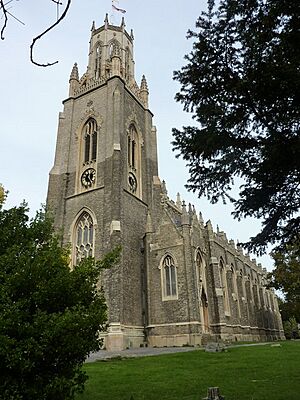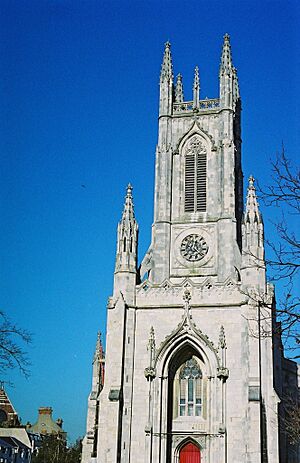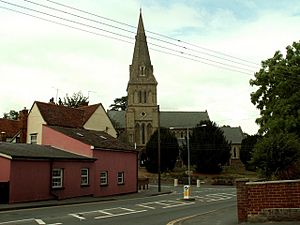List of Commissioners' churches in eastern England facts for kids
A Commissioners' church is a special type of Anglican church built in the United Kingdom. These churches were constructed using money approved by the British Parliament. This happened after a law called the Church Building Act of 1818 was passed, along with other similar laws.
These churches are known by several names, including "Commissioners' Churches," "Waterloo Churches," and "Million Act Churches." The government, through a group called the Commissioners, sometimes paid for the entire church. Other times, they gave a grant, and local people raised the rest of the money. This article looks at Commissioners' churches found in the East of England and South East England.
Contents
Understanding Church Grades
When old buildings in the UK are important, they get a special "grade." This helps protect them. Here's what the grades mean:
| Grade I | These are buildings that are super important and special. They might even be famous around the world! | ||||||||||||
|---|---|---|---|---|---|---|---|---|---|---|---|---|---|
| Grade II* | These buildings are also very important and have a lot of special history or design. | ||||||||||||
| Grade II | These are buildings that are important to the country and have special features. | ||||||||||||
| "—" means the building is not graded. | |||||||||||||
Building New Churches
After the Napoleonic Wars ended in 1815, Britain's population grew very quickly. Many people moved to towns and cities for work. But there weren't enough churches for everyone. The government decided to help build new churches to meet this need. This is why these churches are sometimes called "Waterloo Churches," linking them to the end of the wars.
The Church Building Act of 1818 set up a group of "Commissioners." Their job was to decide where new churches were needed and how much money to give. They wanted to make sure there were enough places for people to worship.
Architects and Styles
Many different architects designed these churches. They often used popular styles of the time:
- Gothic Revival: This style looked back to medieval churches with pointed arches, stained glass, and tall spires. Many Commissioners' churches used this style.
- Neoclassical: This style was inspired by ancient Greek and Roman buildings, with grand columns and simple, balanced shapes.
- Romanesque Revival: This style copied the look of older, round-arched churches from the 11th and 12th centuries.
- Tudor Revival: This style brought back elements from the Tudor period, like brickwork and specific window shapes.
Some churches built during this time are still standing today, while others have been changed, damaged, or even demolished over the years.
Notable Churches and Their Stories
Many interesting churches were built thanks to the Commissioners' grants. Here are a few examples from East and South East England:
St John the Divine, Chatham, Kent
Built between 1821 and 1822, this church received a large grant of £13,797. It was designed by Robert Smirke in the Neoclassical style, featuring grand Doric columns. The church closed in 2004 and is a Grade II* listed building, meaning it's very important.
St George, Ramsgate, Kent
This church, built from 1824 to 1827, got £9,000. Henry Hemsley designed it in the Gothic Revival style, with a tall west tower. It has been repaired and updated several times, including after World War II. It's a Grade I listed building, making it exceptionally important.
St Peter, Brighton, East Sussex
Designed by the famous architect Charles Barry (who also worked on the Houses of Parliament!), this church was built from 1826 to 1828. It's in the Gothic Revival style with a west tower. A chancel (the part of the church near the altar) was added later in 1906. It's a Grade II* listed building.
Holy Trinity, Tunbridge Wells, Kent
Built by Decimus Burton between 1827 and 1829, this church received £8,059. It's another example of the Gothic Revival style, with a west tower. It is also a Grade II* listed building.
Holy Trinity, Halstead, Essex
This church was built from 1843 to 1844 by two well-known architects, George Gilbert Scott and William Moffatt. It's in the Gothic Revival style with a southwest tower and spire. It is a Grade II* listed building.
St Paul, Brighton, East Sussex
Built between 1846 and 1848, this church was designed by Richard Cromwell Carpenter. It's a Gothic Revival church with a tower. A spire was added in 1874, and a narthex (an entrance hall) in 1887. It is a Grade II* listed building.
Holy Trinity, Winchester, Hampshire
Designed by Henry Woodyer, this Gothic Revival church was built in 1853. It features a turret and is a Grade II* listed building.
Images for kids
See also
- List of Commissioners' churches in the English Midlands
- List of Commissioners' churches in London
- List of Commissioners' churches in Northeast and Northwest England
- List of Commissioners' churches in southwest England
- List of Commissioners' churches in Wales
- List of Commissioners' churches in Yorkshire



















